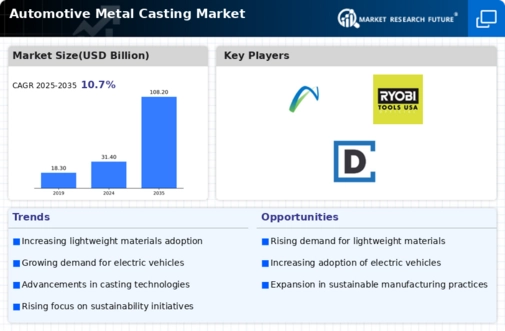Market Share
Automotive Metal Casting Market Share Analysis
In the competitive landscape of the Automotive Metal Casting Market, companies deploy various strategies to carve out their niche and secure market share. One prevalent approach is differentiation, where companies focus on producing unique metal casting components that set them apart from competitors. This could involve offering specialized casting techniques, such as high-pressure die casting or investment casting, which result in superior quality or cost-efficiency. Moreover, companies might differentiate through innovation, introducing novel alloys or design features that enhance performance or aesthetics. By offering distinct value propositions, companies can attract customers seeking specific benefits, thus capturing a portion of the market share.
With the boom in automotive production, across the globe the automotive chassis and exterior account for a major share in the development of the automotive metal casting market.
Another common strategy in market share positioning within the Automotive Metal Casting Market is cost leadership. Companies aim to become the lowest-cost producer in the market by optimizing manufacturing processes, sourcing materials efficiently, and streamlining operations. This enables them to offer competitive pricing to customers while still maintaining acceptable profit margins. Cost leadership is particularly effective in capturing market share among price-sensitive customers or in segments where price plays a significant role in purchasing decisions. Additionally, achieving economies of scale through high-volume production further reinforces this strategy, allowing companies to spread fixed costs across a larger output and lower per-unit costs.
Furthermore, companies in the Automotive Metal Casting Market often pursue niche targeting as part of their market share positioning strategy. Instead of competing across the entire market, they concentrate on specific segments or applications where they can excel. This could involve focusing on casting components for particular vehicle types, such as trucks or luxury cars, or catering to industries beyond automotive, such as aerospace or industrial machinery. By specializing in niche markets, companies can become experts in their chosen domain, building strong relationships with customers and enjoying higher margins due to reduced competition.
Collaboration and partnerships also play a vital role in market share positioning within the Automotive Metal Casting Market. Companies may form alliances with automakers, tier-one suppliers, or technology providers to leverage complementary strengths and expand their market reach. Collaborative ventures could involve co-development of innovative casting solutions, joint marketing efforts, or shared distribution channels. By pooling resources and expertise, companies can enhance their competitive position and capture market share more effectively, especially in rapidly evolving areas such as electric vehicles or lightweighting technologies.
Additionally, strategic investments in research and development (R&D) are crucial for securing market share in the Automotive Metal Casting Market. By continuously investing in innovation and technology, companies can stay ahead of competitors and offer cutting-edge casting solutions that address emerging trends and customer needs. This could involve developing new casting materials with improved properties, enhancing manufacturing processes for greater efficiency and flexibility, or integrating digital technologies such as 3D printing or simulation software. R&D investments not only strengthen a company's market position but also foster long-term growth and sustainability in the highly dynamic automotive industry.






Leave a Comment